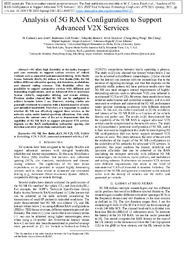Por favor, use este identificador para citar o enlazar este ítem:
https://hdl.handle.net/11000/8040Registro completo de metadatos
| Campo DC | Valor | Lengua/Idioma |
|---|---|---|
| dc.contributor.author | Lucas Estañ, María del Carmen | - |
| dc.contributor.author | Coll Perales, Baldomero | - |
| dc.contributor.author | Wang, Chang-Heng | - |
| dc.contributor.author | Shimizu, Takayuki | - |
| dc.contributor.author | Avedisov, Sergei | - |
| dc.contributor.author | Higuchi, Takamasa | - |
| dc.contributor.author | Cheng, Bin | - |
| dc.contributor.author | Yamamuro, Akihiko | - |
| dc.contributor.author | Gozalvez, Javier | - |
| dc.contributor.author | Sepulcre, Miguel | - |
| dc.contributor.author | Altintas, Onur | - |
| dc.contributor.other | Departamentos de la UMH::Ingeniería de Comunicaciones | es |
| dc.date.accessioned | 2021-07-22T07:29:02Z | - |
| dc.date.available | 2021-07-22T07:29:02Z | - |
| dc.date.created | 2021-06-15 | - |
| dc.date.issued | 2021-07-22 | - |
| dc.identifier.uri | http://hdl.handle.net/11000/8040 | - |
| dc.description.abstract | 5G offers high flexibility at the radio, transport and core networks to support various services of critical verticals such as connected and automated driving. At the Radio Access Network (RAN), 5G defines a New Radio (NR). 5G NR utilizes different subcarrier spacing, slot durations, modulations and channel coding schemes. This flexibility offers the possibility to support automotive services with different and demanding requirements, such as Advanced Driver-Assistance System (ADAS), cooperative driving, and remote driving. Previous studies showed that 5G NR can be configured to achieve latencies below 2 ms. However, existing studies are generally restricted to scenarios with a limited number of users and unlimited bandwidth. Therefore, it is important to analyze whether 5G NR can effectively support these services as the network scales under limited spectrum allocations. This study advances the current state of the art to demonstrate that the capability of 5G NR RAN to support advanced V2X services depends on the RAN configuration (subcarrier spacing, slot duration and error protection) and network load | es |
| dc.description.sponsorship | UMH work was supported in part by the Spanish Ministry of Science and Innovation (MCI), AEI and FEDER funds under Project TEC2017-88612-R, | - |
| dc.description.sponsorship | and the Ministry of Universities (IJC2018-036862-I), and the Generalitat Valenciana | - |
| dc.format | application/pdf | es |
| dc.format.extent | 5 | es |
| dc.language.iso | eng | es |
| dc.rights | info:eu-repo/semantics/openAccess | es |
| dc.subject | 5G | es |
| dc.subject | NR | es |
| dc.subject | New Radio | es |
| dc.subject | RAN | es |
| dc.subject | 5G V2X | es |
| dc.subject | V2X | es |
| dc.subject | Vehicle to Everything | es |
| dc.subject | V2N | es |
| dc.subject | V2N2V, | es |
| dc.subject | connected automated vehicles | es |
| dc.subject | CAV | es |
| dc.subject.other | 621.3 - Ingeniería eléctrica. Electrotecnia. Telecomunicaciones | es |
| dc.title | Analysis of 5G RAN Configuration to Support Advanced V2X Services | es |
| dc.type | info:eu-repo/semantics/article | es |
| dc.identifier.doi | 10.1109/VTC2021-Spring51267.2021.9448727 | - |
| dc.relation.publisherversion | https://doi.org/ 10.1109/VTC2021-Spring51267.2021.9448727 | - |

Ver/Abrir:
3-VTC2021-Spring-Analysis of 5G RAN Config to Support Advanced V2X Services.pdf
387,67 kB
Adobe PDF
Compartir:
 La licencia se describe como: Atribución-NonComercial-NoDerivada 4.0 Internacional.
La licencia se describe como: Atribución-NonComercial-NoDerivada 4.0 Internacional.
.png)